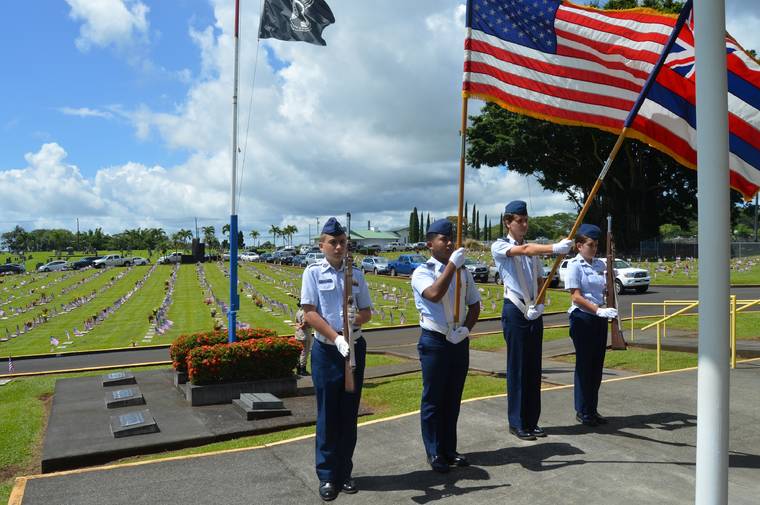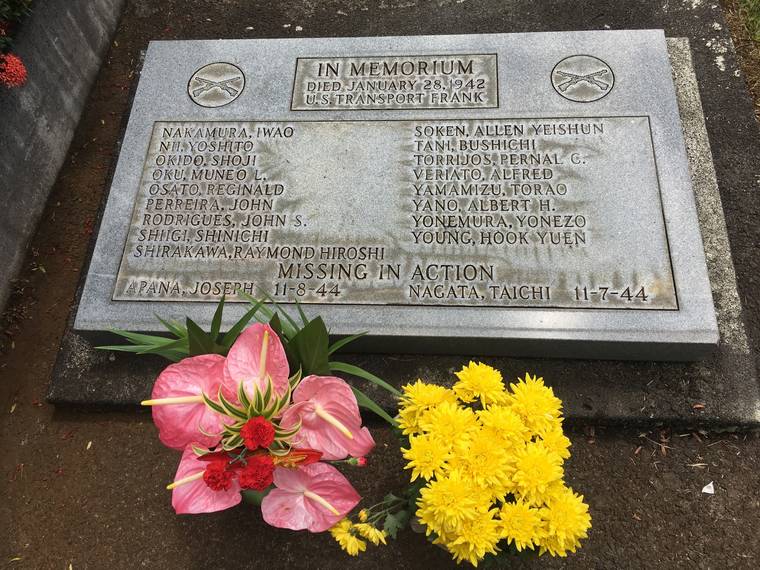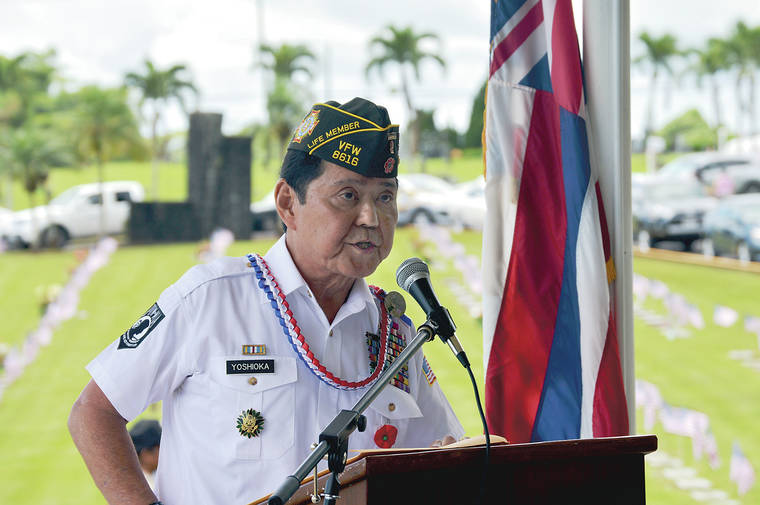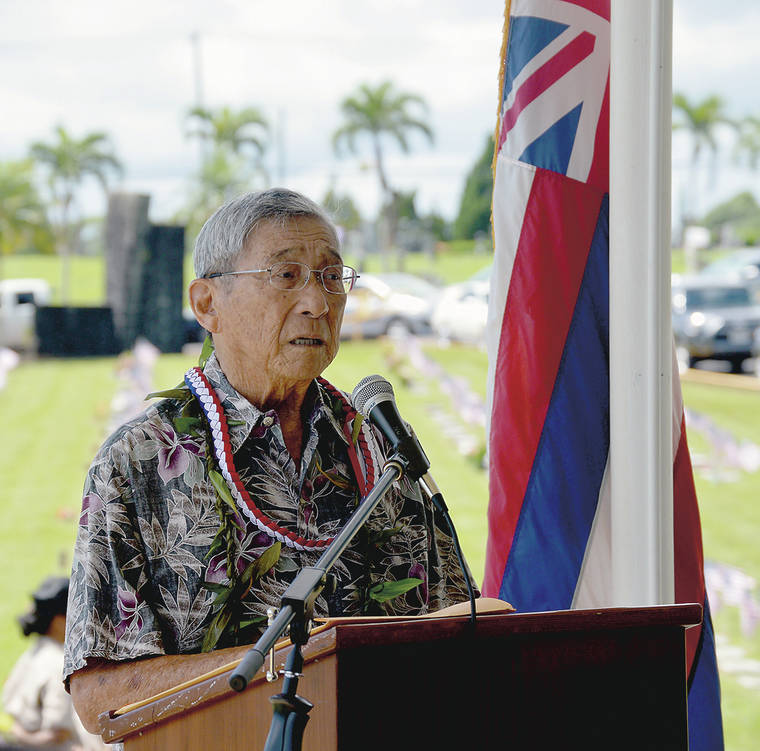Honoring the fallen: Speakers at Memorial Day event talk of service, sacrifice




For most, Memorial Day holiday is just a paid holiday from work — celebrating the unofficial start of summer at the beach with family and friends, or with burgers grilled in the backyard and adult beverages.
For the families of those who died in America’s wars and their comrades-in-arms who recall their ultimate sacrifice, however, it is a solemn occasion, a day of remembrance.
ADVERTISING
As it does yearly, Veterans of Foreign Wars Post 3830 and VFW Auxiliary 3830 in Pahoa hosted a special ceremony Monday at Hawaii Veterans Cemetery No. 1 in Hilo. The Hawaii County Band played military marches and “Taps,” and a funeral volley was fired to remember those whose headstones were marked with American flags, colors were posted and prayers were uttered.
“We come here to celebrate life, just by your mere presence,” said Debra Lewis, a retired Army colonel and VFW Post 3830 commander. “We come here to honor life, by remembering those who went before us and all the sacrifices they’ve made so we can enjoy this beautiful paradise. And we come here in order to strengthen life. Because if we don’t tell these stories, who will?”
Mayor Harry Kim and Councilwoman Sue Lee Loy were among the 100 or so in attendance. Kim noted an opinion piece in Monday’s edition of the Tribune-Herald in which the author cited a 2001 Gallup Poll that concluded only 28 percent of Americans knew the actual meaning and purpose of Memorial Day.
“How can three-fourths of the people not know what this day is all about?” Kim, who served as an Army combat medic in the Vietnam War, lamented. “… Just think about that. Three-fourths of the Americans in the United States of America — the most blessed place to live … because of veterans — don’t know what this day’s about.”
Kim noted most of those in attendance were either families of service members killed in duty or veterans like himself.
The Royal T. Frank, a little-known Army transport ship torpedoed and sunk by a Japanese submarine off the Maui coast on Jan. 26, 1942, was memorialized. The Frank, in convoy with a Navy destroyer and towing an ammunition barge, was transporting 26 Hawaii Island soldiers who had just completed basic training at Schofield Barracks from Honolulu to Hilo.
“Twenty-nine lives were lost, 12 crew members and 17 servicemen,” Lewis said. “… In the year 2000, after 58 years, a special ceremony was held right here, where a granite memorial was placed near this flagpole and dedicated to the fallen servicemen from the Royal T. Frank.”
The names of the soldiers killed in the sinking of the Royal T. Frank are inscribed on the memorial. They are: Iwao Nakamura, Yoshito Nii, Shoji Okido, Muneo L. Oku, Reginald Asato, John Perreira, John S. Rodrigues, Shinichi Shiigi, Raymond Hiroshi Shirakawa, Allen Yeishun Soken, Bushichi Tani, Pernal C. Torrijos, Alfred Veriato, Torao Yamamizu, Albert H. Yano, Yonezo Yonemura and Hook Yuen Young.
Two other World War II service members who went missing in action in November 1944 are also listed on the granite memorial — Joseph Apana and Taichi Nagata.
Nine soldiers survived the sinking of the Frank. Those nine — Shigeru Ushijima, George Taketa, Yoshio Ogomori, John Souza, Shizuo Toma, Mac Wakimoto, Haruo Yamashita, Tokimaru Takamoto and Susumu Yoshioka — became known as the “Torpedo Gang.”
“After the war, these nine survivors found each other … and vowed to have an annual reunion on the anniversary of the attack on the Royal T. Frank, to honor and remember their fallen comrades, just as we honor our fallen comrades today. The Torpedo Gang survivors and families kept true to this pact and met annually until the early 2000s,” Lewis said. “While the Torpedo Gang survivors are now, sadly, all gone, we are honored to have several family members here today to honor the legacy of their loved ones — and to remember their stories of sacrifice, service and brotherly love of these brave servicemen.”
Those present include: Greg and Patrick Taketa, sons of George Taketa; and Eleanor Hirano and Lori Udo, nieces of Shigeru Ushijima; plus several relatives of Susumu Yoshioka. They are Yoshioka’s younger brother Fumio Yoshioka, his wife, Yoshiko, and their son, Colin; his sister-in-law, Tamayo Yoshioka, her son and Susumu Yoshioka’s nephew, Wayne Yoshioka, and his wife, Vicki Bentzien.
Wayne Yoshioka, a Papaikou native and Hilo High School graduate, is a retired Army lieutenant colonel who was also an award-winning reporter at KITV-4 in Honolulu and political reporter for Hawaii Public Radio. A highly-decorated combat veteran in Afghanistan who was awarded the Legion of Merit and Bronze star, he spoke about the sinking of the Frank — crediting a 1986 article by Karleen Chinen in the Hawaii Herald for much of his knowledge of the story.
“The nine surviving soldiers and ship’s crew were taken to the gymnasium in Hana, Maui, which had been converted into a first-aid station. The sunken transport ship and the remains of those killed were never recovered — and the survivors were ordered by military leaders to not discuss the incident with anyone. Family members of those who were killed were never told of the attack, and the story of the Royal T. Frank was, and is, still today, unknown to many,” Yoshioka said.
“Uncle Susumu hurt his back that day in the Royal T. Frank sinking, but went on to serve with the 100th Infantry Battalion, ‘Go for Broke.’ As we know, the unit was mostly comprised of second-generation, or nisei, Americans of Japanese ancestry. The ‘One-Puka-Puka’ would become the most decorated unit of its size in World War II.”
As a member of the 100th’s Bravo Co., Susumu Yoshioka served in North Africa and the Rhineland in Germany, was taken prisoner of war in January 1945, and imprisoned in Stalag 7 near Moosburg, Bavaria.
“According to my Uncle Fumio, he remembers his mother fainting when she was told by a plantation supervisor that Susumu was missing in action,” Wayne Yoshioka said.
Susumu Yoshioka suffered a service-related back injury in the sinking of the Frank and became a shoe and canvas repairer at Pearl Harbor Naval Shipyard after the war, his nephew said.
“Uncle Susumu loved talking about the war and about the close calls he had — like relieving himself under a tree and walking back to the foxhole just as an artillery round exploded in the puddle he left behind,” Yoshioka quipped. “… He told us as we were growing up, that he knew which one of his fellow soldiers he could count on to fight and which ones would hide. He also told us how he could see the bullets spinning as they came toward him.
“And when his wife and daughter were not around, he would tell us how the war was the high point of his life — how much he enjoyed it and how much he really missed it.”
In the 1970s Susumu Yoshioka changed his name to Clay Susumu Yoshioka. At the wedding of Wayne Yoshioka and Vicki Bentzien, Uncle Clay swapped war stories with Bentzien’s father, Robert, who served in World War II as an Army paratrooper in the 17th Airborne Division — including a stint in the Rhineland, not far from where the 100th Battalion was fighting.
Ironically, both Clay Susumu Yoshioka and Bob Bentzien died of congestive heart failure in 2008. Wayne Yoshioka said one of his family’s treasures is a photo of the two together.
“Bob’s arms are stretched overhead, as in a parachute landing fall, and my Uncle Susumu is crouched down, listening intently. It’s really a wonderful keepsake for our family. You know, two soldiers from the so-called ‘Greatest Generation’ — a second-generation Japanese-American and third-generation German-American who fought on the same side.”
Email John Burnett at jburnett@hawaiitribune-herald.com.








